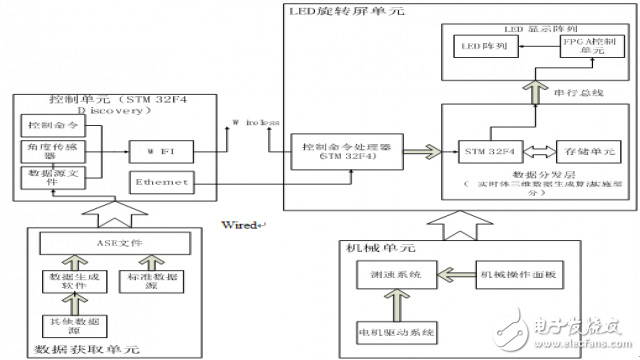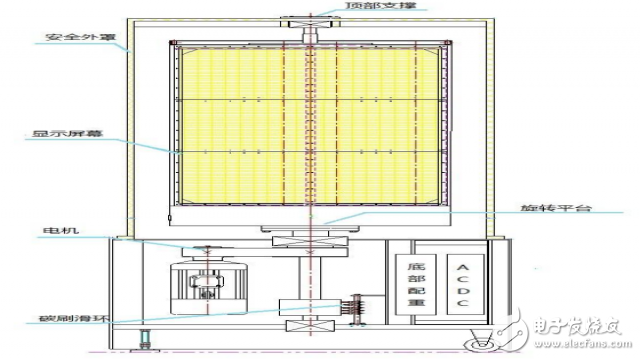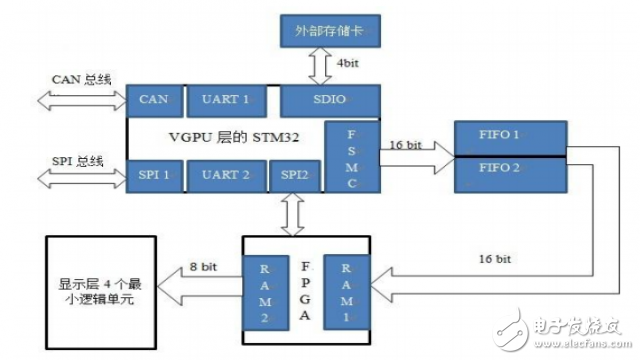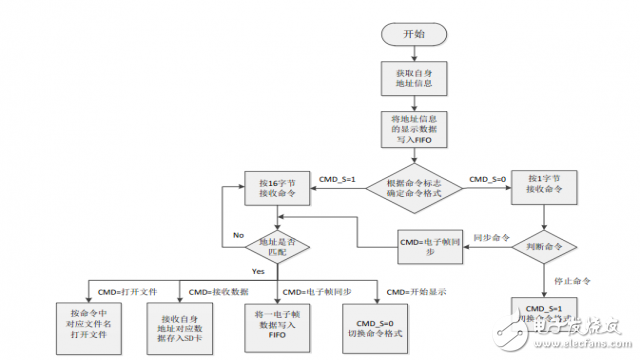

现实的世界是一个拥有宽度、高度和深度的三维立体世界。在平面二维显示技术已经成熟的今天,三维立体显示技术首当其冲的成为了当今显示技术领域的研究热点。
本作品搭建了基于stm32f4的三维旋转显示平台,它的显示原理属于三维显示中的体三维显示一类。它是通过适当方式来激励位于透明显示体内的物质,利用可见辐射光的产生三维体像素。当体积内许多方位的物质都被激励后,便能形成由许多分散的体像素在三维空间内构成三维图像。
体三维显示又称为真三维显示,因为他所呈现的图像在真实的三维空间中,展示一个最接近真实物体的立体画面,可同时允许多人,多角度裸眼观看场景,无序任何辅助眼镜。
本作品的特点在于,利用stm32f4的浮点运算能力,实现了低成本的体三维显示数据的生产,并利用类似分布式处理的系统结构,满足了体三维显示所需要的巨大数据吞吐量,等效吞吐量可达约300Mb/s
1.系统方案众所周知人眼在接收被观察物体的信息时,携带物体信息的光信号通过人眼细胞及神经传入大脑神经,光的作用时间只是一个很短暂的时间段,当光的作用时间结束后,视觉影像并不会立即消失,这种残留的视觉称“后像”,视觉的这一现象则被称为“视觉暂留”( duraTIon of vision)物体在快速运动时, 当人眼所看到的影像消失后,人眼仍能继续保留其影像0.1---0.4秒左右的图像。在空间立体物体离散化的基础上,再利用人眼视觉暂留效应,基于LED阵列的“三维体扫描”立体显示系统便实现了立体显示效果。如图1所示,以显示一个空心的边长为单位1的正方体为例。LED显示阵列组成的二维显示屏即为正方体每个离散平面的显示载体,LED显示屏上的被点亮的LED即为正方体的平面离散像素。我们将该LED显示平面置于轴对称的角度机械扫描架构内,在严格机电同步的立体柱空间内进行各离散像素的寻址、赋值和激励,由于机械扫描速度足够快,便在人眼视觉上形成一个完整的正方体图像。图1(a)所示为立方体0度平面二维切片图,图1(b)所示为立方体45度平面二维切片图,图1(c)所示为立方体135度平面二维切片图,图1(d)所示为立方体180度平面二维切片图,图1(e)所示为观看者观察到的完整立方体显示效果。

图1
系统方案如图2所示,整个系统由四个模块组成,其中数据获取单元主要由在PC上的上位机完成,利用3D-Max,OpenCV,OpenGL,将三维建模数据转化成三维矢量表述文件,传给由STM32F4 Discovery开发板构成的控制单元,利用其上的角度传感器,结合wifi模块或以太网模块通过电力线模式传给LED旋转屏单元,其中的STM32F4负责将ASE文件解析成LED显示阵列所需的点云数据流,通过串行总线传输给由FPGA驱动的LED显示阵列,通过LED刷新速率与机械单元旋转速率相匹配,从而实现体三维显示的效果。

图2
2.系统硬件设计系统的机械部分如图3所示,显示面板的硬件结构如图4,图5所示。本系统的底部是直流电机和碳刷,直流电机主要负责带动上层的显示屏幕高速旋转,而碳刷则负责传递能量和通信信号。在显示屏幕的正面是由96*128构成的三色LED点阵,FPGA的PWM信号通过驱动芯片控制三色LED从而实现真彩显示。在屏幕背面由多块STM32F4,SD卡,FIFO构成,主要负责解析由控制单元传过来的ASE文件,并实时生成体三维显示数据,并传给LED灯板的驱动FPGA,并通过其实现最终的图像显示。

图3

图4

图5
3.系统软件设计3.1软件控制流程:

3.2关于实时生成体三维显示数据的讨论:
一个瓦片64*32
LED层FPGA*8:每个16*16LED
中间层stm32*2:每个4LED层的FPGA,也即32*32
由于经过压缩,一个led数据为4bits
所以一个stm32每一帧所要生成的数据为32*32*0.5bytes = 512bytes
转速800转,一帧1/800s = 1.25ms = 1250000ns
stm32f4主频168Mhz,指令周期 = 5.93ns
约可执行20万多条指令
假设fsmc总线的速度为50Mhz,则每帧写入的时间大概在0.02ms内
程序总体思路
事先算出所有电子帧上非零的点,以及连续0的个数,在每一个电子帧同步后,算出生成下一帧的数据,写入fifo
输入:线段端点的集合
//input: endpoints of segments which formed the outline of a 3D model
//x posiTIon with range 0-95
//y posiTIon with range 0-95
//z posiTIon with range 0-128
/******************************************/
//from later discussion, one of the Q format
//type should replace the char type
/******************************************/
struct Coordinate_3D
{
_iq xPosition;
_iq yPosition;
_iq zPosition;
};
//after you get the intersection points in 3d coordinate, you need to remap it into 2d coordinate on the very electrical plane,
//and the conversion is quite simple Coordinate_2D.yPosition = Coordinate_3D.zPosition; Coordinate_2D.xPosition = sqrt(xPosition^2+yPosition^2)
struct Coordinate_2D
{
char xPosition;
char yPosition;
};
struct Line
{
struct Coordinate_3D beginPoint;
struct Coordinate_3D endPoint;
unsigned char color;
};
//frame structure to store the visible points in one electrical frame
//need to be discussed
//here's the prototype of the Frame structure, and basically the frame struture should contain the visible points,
//and the zero points. As we have enclosed the number of zero points after each visible points in their own data structure,
//only the number of zero points at the beginning of the whole frame should be enclosed in the frame struture
struct Frame
{
int zerosBefore;
PointQueue_t visiblePointQueue;
};
//we need a union structure like color plane with bit fields to store the color imformation of every four FPGAs in one data segment
//actually, it's a kind of frustrateing thing that we had to rebind the data into such an odd form.
union ColorPalette
{
struct
{
unsigned char color1 : 4;
unsigned char color2 : 4;
unsigned char color3 : 4;
unsigned char color3 : 4;
}distributedColor;
unsigned short unionColor;
};
//and now we need a complete point structure to sotre all the imformation above
//here we add a weight field = yPosition*96 + xPosition, which will facilitate
//our sort and calculation of the zero points number between each visible point
//it's important to understand that, 4 corresponding points on the LED panel
//will share one visiblepoint data structure.(一块stm32负责4块16*16的LED,每块对应的点的4位颜色信息,拼成16位的数据段)
struct VisiblePoint
{
struct Coordinate_2D coord;
union Colorplane ColorPalette;
int weight;
int zerosAfter;
};
//as now you can see, we need some thing to store the visible points array
typedef struct QueueNode
{
struct VisiblePoint pointData;
struct QueueNode * nextNode;
}QueueNode_t, *QueueNode_ptr;
typedef struct
{
QueueNode_ptr front;
QueueNode_ptr rear;
}PointQueue_t;
//finally, we will have 16*16 words(16 bits)to write into the fifo after each electrial frame sync cmd.
//it may hard for us to decide the frame structure now, let's see how will the work flow of the algorithm be.
//firstly, the overall function will be like this
void Real3DExt(struct Line inputLines[], int lineNumber, struct Frame outputFrames[])
//then we need some real implementation function to calculate the intersection points
//with 0 = no intersection points, 1 = only have one intersection points, 2 = the input line coincides the given electrical plane
//2 need to be treated as an exception
//the range of the degree is 0-359
//it's important to mention that each intersection point we calculate, we need to
//remap its coordinate from a 32*32 field to x,y = 0-15, as each stm32 only have a 32*32
//effective field(those intersection points out of this range belong to other stm32), which can be decided by its address
int InterCal(struct Line inputLine, struct VisiblePoint * outputPoint, int degree)
//so we will need something like this in the Real3DExt function:
for (int j = 0; j < 360; j++)
{
for(int i = 0; i < lineNumber; i++ )
InterCal(struct Line inputLine, struct VisiblePoint outputPoint, int degree);
......
}
/******************************************/
//simple float format version of InterCal
/******************************************/
//calculate formula
//Q = [-1,1,-1];
//P = [1,1,-1];
//V = Q - p = [-2,0,0];
//Theta = pi/6;
//Tmp0 = Q(1)*sin(Theta) - Q(2)*cos(Theta);
//Tmp1 = V(1)*sin(Theta) - V(2)*cos(Theta);
//Result = Q - (Tmp0/Tmp1)*V
float32_t f32_point0[3] = {-1.0f,1.0f,-1.0f};
float32_t f32_point1[3] = {1.0f,1.0f,-1.0f};
float32_t f32_directionVector[3], f32_normalVector[3], f32_theta,
f32_tmp0, f32_tmp1, f32_tmp2, f32_result[3];
arm_sub_f32(f32_point0,f32_point1,f32_directionVector,3);
f32_theta = PI/6.0f;
f32_normalVector[0] = arm_sin_f32(f32_theta);
f32_normalVector[1] = arm_cos_f32(f32_theta);
f32_normalVector[2] = 0.0f;
arm_dot_prod_f32(f32_point0, f32_normalVector, 3, &f32_tmp0);
arm_dot_prod_f32(f32_directionVector, f32_normalVector, 3, &f32_tmp1);
f32_tmp2 = f32_tmp0/f32_tmp1;
arm_scale_f32(f32_normalVector, f32_tmp2, f32_normalVector, 3);
arm_sub_f32(f32_point0, f32_normalVector, f32_result, 3);
//and than we need to decide whether to add a new visible point in the point queue, or to update
//the color field of a given point in the point queue(as 4 visible point share one data structure). from this point, you will find that, it may be
//sensible for you not to diretly insert a new point into the end of point queue but to insert it in order
//when you build the pointqueue. it seems more effective.
void EnPointQueue(PointQueue_t * inputQueue, QueueNode_t inputNode);
//finally we will get an sorted queue at the end of the inner for loop
//than we need to calculate the number of invisible points between these visible points
//and to store it in each frame structure. the main purpose to do so is to offer an quick generation
//of the blank point(color field = 16'b0) between each electrical frame
//the work flow will be like this:
loop
{
dma output of the blank points;
output of the visible points;
}
/******************************************/
//some points need more detailed discussion
/******************************************/
//1.memory allocation strategy
//a quite straight forward method will be establishing a big memnory pool in advance, but the drawback of this method
//is that it's hard for you to decide the size of the memory pool. Another way would be the C runtime library method,
// and you can use build-in function malloc to allocate the memory, but it will be a quite heavy load for the m3 cpu
// as you need dynamic memeory allocation throughout the algorithm.
//2.the choice of Q format of the IQMATH library
//from the discussion above, the range of the coordnate is about 1-100, but the range of sin&cos is only 0-1,so there's a large gap between them.
//may be we can choose iq24?? Simultaneously, another big problem will be the choice between IQMATH and arm dsp library as their q format is
//incompatible with each other. as far as my knowledge is concerned, we should choose IQMATH with m3 without fpu, and cmsis dsp library with m4 with fpu.
//more detail discussion about the range of the algorithm
//x,y range is -64 to 64
//the formula is
//Tmp0 = Q(1)*sin(Theta) - Q(2)*cos(Theta);
//Tmp0 range is -128 to 128
//Tmp1 = V(1)*sin(Theta) - V(2)*cos(Theta);
//Tmp1 range is -128 to 128
//Result = Q - (Tmp1/Tmp2)*V
//because the minimal precision of the coordinate is 1, so if the result of Tmp1/Tmp2 is bigger than 128, the Result will be
//saturated. With the same reson, if (Tmp1/Tmp2)*V >= 128 or <= -127, the result will be saturated
4.系统创新欢迎分享,转载请注明来源:内存溢出

 微信扫一扫
微信扫一扫
 支付宝扫一扫
支付宝扫一扫
评论列表(0条)